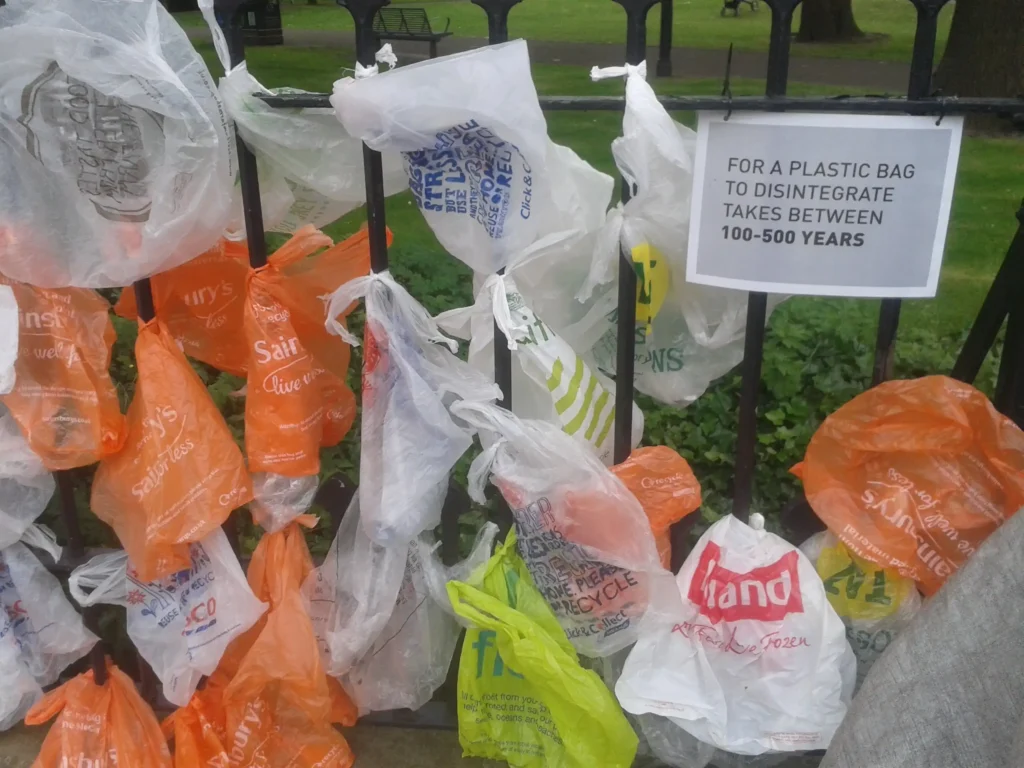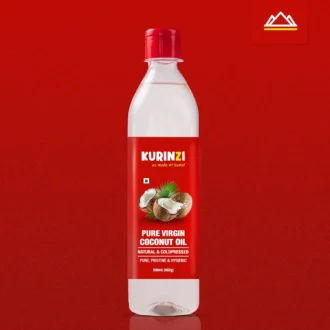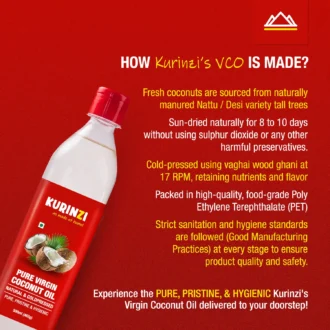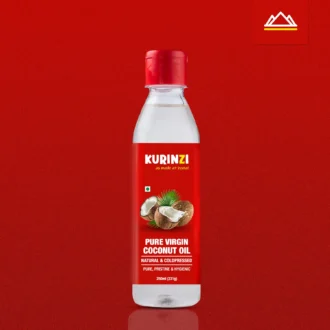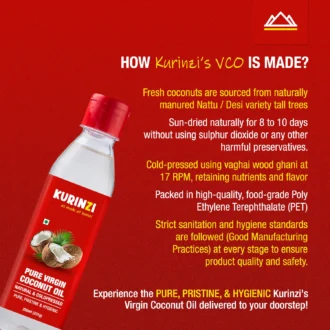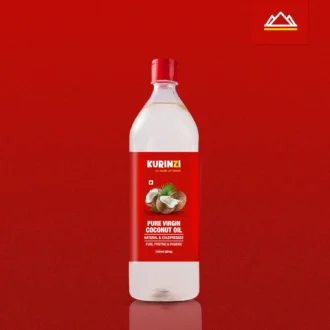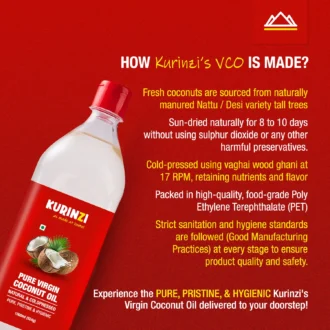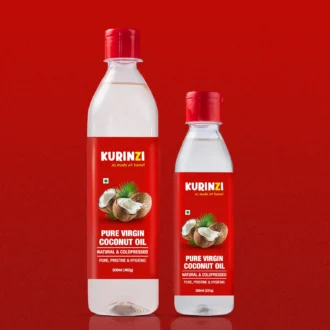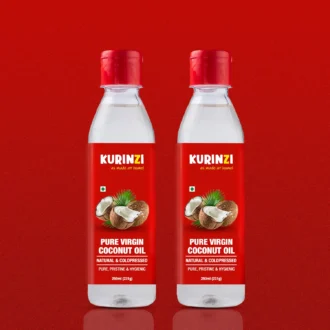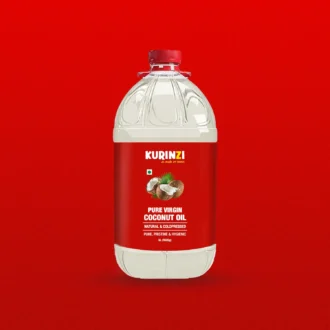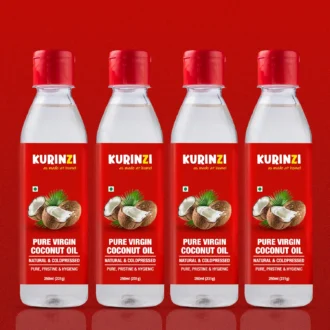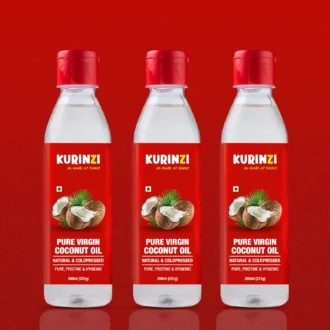Packaging
Is 100% biodegradable plastic a greenwashing?
Our extensive research and analysis on finding the right packaging material for Kurinzi’s Virgin Coconut Oil
As I was reading a news article today, it reminded me of our research on finding the right packaging material for Kurinzi’s Virgin Coconut Oil. When we decided to start manufacturing and distributing Kurinzi’s Virgin Coconut Oil, the first thing that popped into my mind was: how are we going to pack it, store it, and transport it? Which packaging material should we use? And how will our customers be using it?
I had many questions, but my main concern was the safety and non-toxicity of the packaging material to prevent any contamination of the oil, which should also be healthy for human consumption. Additionally, it should be durable enough to withstand storage, transportation, and easy for daily use, without adding too much to the overall cost of our product. I don’t want our customers to pay extra just for fancy packaging. Furthermore, it should be easily available and consistently supplied.
So I looked up the suggested packaging materials for Fats, Oils, and Fat Emulsions under the Food Safety and Standards (Packaging and Labelling) Regulations.
Here’s what I found:
- Tin plate container
- Glass bottle with metal or plastic caps
- Rigid plastic container (made of HDPE)
- Plastic bottle or jar (made of PET) with plastic caps
- Multi-layered laminated or co-extruded plastic pouch
- Aseptic and flexible packaging material (made of paper, aluminum foil, or polyethylene)
- Plastic laminated pouch in a duplex board box (a.k.a. “Bag in Box”)
- Thermoformed plastic jar with plastic caps
- Paper-based lined cartons with an aluminum foil-based laminated structure
I knew I had to study each material’s advantages and disadvantages to decide which one was the best for us. It took me some time, but the effort was worth it as it helped me gain a better understanding of the intricacies of each packaging material available to us. Plus, it helped me to explain to our loyal customers why we chose a particular packaging material.
Now, let’s delve into the details.
Tin plate container:
Tinplate containers are commonly used for packaging fats, oils, and fat emulsions. These containers have a metal lining that provides a protective barrier against oxidation and contamination, ensuring the product stays fresh. The metal container is also durable and can withstand transportation and handling. However, tinplate containers are not suitable for acidic or alkaline products as they can cause corrosion. Additionally, they are not as environmentally friendly as other packaging materials, as they are not easily recyclable and can contribute to waste.

Advantages:
- Tinplate containers are durable, sturdy and can withstand high pressure, making them ideal for storing and transporting fats, oils and emulsions.
- They offer good protection against light and oxygen, which can cause spoilage of the product.
- They are recyclable and have a long shelf life.
Disadvantages:
- Tinplate containers may contain traces of bisphenol A (BPA), a harmful chemical that can cause health problems.
- They are heavy, which can increase transportation costs.
- Using and dispensing them on a daily basis can be quite difficult, making them inconvenient for consumers.
Glass bottle with metal caps or plastic polypropylene (PP) or High-density polyethylene (HDPE) caps:
Glass bottles with metal or plastic caps are a popular packaging option for fats, oils, and fat emulsions. Glass is an inert material that does not react with the product, ensuring the taste and quality of the product remains unchanged. Glass is also 100% recyclable and can be reused numerous times. However, glass is fragile and can break during transportation and handling, making it more expensive to transport. The metal or plastic caps provide a secure seal that prevents leakage or contamination.

Advantages:
- Glass bottles are inert and do not react with the product, preserving its flavor and quality.
- They are reusable and recyclable, making them environmentally friendly.
- Glass is a good barrier against oxygen and light, which can extend the shelf life of the product.
Disadvantages:
- Glass bottles are heavy, which can increase transportation costs.
- They are fragile and can break easily, making them difficult to handle during transportation and storage.
- They require extra care when being used and dispensed on a daily basis, which can make them quite difficult and inconvenient for consumers.
Plastic rigid container (Jar) made of High-density polyethylene (HDPE):
Plastic jars made of HDPE are a lightweight and durable packaging option for fats, oils, and fat emulsions. HDPE is a highly resistant material that can withstand impacts, making it suitable for transportation and handling. Additionally, HDPE is recyclable and can be repurposed into other products. However, plastic containers can leach chemicals into the product, potentially affecting its taste or quality. They also have a limited shelf life compared to glass containers.

Advantages:
- HDPE containers are lightweight, making them cost-effective for transportation.
- They are durable and can withstand rough handling during transportation and storage.
- HDPE is a good barrier against moisture, which can extend the shelf life of the product.
Disadvantages:
- Plastic containers may contain harmful chemicals that can leach into the product, affecting human health.
- They are not as good a barrier against light and oxygen as other materials, which can lead to spoilage of the product.
- Plastic containers are not biodegradable and can have a negative impact on the environment.
Plastic bottle or Jar Polyethylene terephthalate (PET) with plastic caps:
PET plastic bottles and jars are another popular packaging option for fats, oils, and fat emulsions. PET is a lightweight and durable material that is resistant to impact and provides a secure seal to prevent leakage or contamination. PET is also recyclable, making it an environmentally friendly option. However, PET can also leach chemicals into the product, potentially affecting its taste or quality. PET containers also have a limited shelf life compared to glass containers.
Advantages:
- PET bottles are lightweight and cost-effective for transportation.
- They are shatterproof and can withstand rough handling during transportation and storage.
- PET bottles with an inner plug are highly efficient and easy to use, making them a convenient choice for daily use by consumers.
- PET is a good barrier against oxygen and moisture, which can extend the shelf life of the product.
- PET (Polyethylene Terephthalate) plastic bottles are considered highly recyclable, and are widely accepted by recycling facilities.
Disadvantages:
- PET bottles may contain harmful chemicals that can leach into the product, affecting human health.
- They are not as good a barrier against light as other materials, which can lead to spoilage of the product.
- PET bottles are not biodegradable and can have a negative impact on the environment.

Plastic Pouch made of Multi layered laminated or co-extruded structure:
Plastic pouches made of a multi-layered laminated or co-extruded structure are a lightweight and flexible packaging option for fats, oils, and fat emulsions. The pouches are easy to store, transport, and use, making them convenient for consumers. However, the multi-layered structure makes it difficult to recycle, and the materials used in the packaging can be harmful to the environment.
Advantages:
- Pouches are lightweight and cost-effective for transportation.
- They are flexible and take up less space during transportation and storage.
- Pouches can be customized with high-quality graphics, which can enhance the marketing appeal of the product.
Disadvantages:
- Pouches are not as durable as other materials and can be punctured easily, leading to product leakage.
- They are not as good a barrier against light and oxygen as other materials, which can lead to spoilage of the product.
- Pouches are not biodegradable and can have a negative impact on the environment.
Aseptic and flexible packaging material (Paper board or Aluminium foil or polyethylene) based multilayered structure:
Aseptic and flexible packaging materials made of a multi-layered structure of paper, aluminum foil, or polyethylene are a popular packaging option for fats, oils, and fat emulsions. The aseptic packaging process kills any bacteria, viruses, or fungi, increasing the shelf life of the product. The high barrier properties of the materials used in the packaging protect the product from light, oxygen, and moisture. However, the multilayered structure makes it difficult to recycle, and the aseptic packaging process requires high energy and water consumption.

Advantages:
- Lightweight and flexible, making them easy to transport and store.
- The aseptic packaging process kills any bacteria, viruses, or fungi, increasing the shelf life of the product.
- High barrier properties of the materials used in the packaging protect the product from light, oxygen, and moisture.
Disadvantages:
- The multilayered structure makes it difficult to recycle.
- The aseptic packaging process requires high energy and water consumption.
- The use of aluminum and plastics in the packaging raises concerns about their environmental impact.
Plastic laminated pouch in duplex board box (Bag in Box):
Plastic laminated pouches in a duplex board box, also known as bag-in-box packaging, is a lightweight and cost-effective option for packaging fats, oils, and fat emulsions. The packaging is easy to store, transport, and use, and the pouch provides a barrier against oxygen and moisture, ensuring the product stays fresh. The bag-in-box packaging is also recyclable and environmentally friendly, as it requires less material compared to other packaging options. However, the packaging is not as visually appealing as glass or plastic containers and may not be suitable for certain products.
Advantages:
- The bag-in-box packaging is lightweight and takes up less space, making it cost-effective to transport.
- The packaging is airtight, protecting the product from oxidation and extending its shelf life.
- The pouches are easy to use and dispense, making them convenient for consumers.
Disadvantages:
- The packaging can be difficult to recycle due to the combination of materials used in its construction.
- The production of plastic laminated pouches and cardboard boxes requires significant energy and resources, contributing to environmental concerns.
- The product may not be visible, making it difficult for consumers to know how much is left.
Thermoformed plastic-based jar with plastic caps:
Thermoformed plastic-based jars with plastic caps are a popular packaging option for fats, oils, and fat emulsions. The jars are lightweight and durable, making them suitable for transportation and handling. The plastic material is also recyclable and can be repurposed into other products. However, plastic containers can leach chemicals into the product, potentially affecting its taste or quality. They also have a limited shelf life compared to glass containers.
Advantages:
- The thermoforming process produces lightweight, durable, and stackable containers that are easy to transport and store.
- The plastic material used in the packaging is recyclable.
- The clear plastic jar allows consumers to see the product inside.
Disadvantages:
- Thermoforming requires high energy consumption, and the process can generate waste.
- Plastic packaging is not biodegradable and can contribute to environmental problems.
- The plastic material can interact with the product, affecting its taste or quality.
Paper-based lined cartons with a liner made of an aluminum foil-based laminated structure:
Paper-based lined cartons with a liner made of an aluminum foil-based laminated structure is a cost-effective and lightweight packaging option for fats, oils, and fat emulsions. The cartons are easy to store, transport, and use, and the aluminum foil-based laminated structure provides a barrier against oxygen and moisture, ensuring the product stays fresh. Additionally, the packaging is recyclable and environmentally friendly. However, the packaging may not be suitable for all products, and the aluminum foil layer may make it difficult to recycle.
Advantages:
- Paper-based packaging is biodegradable, recyclable, and renewable.
- The aluminum foil liner provides a barrier against oxygen, light, and moisture, helping to preserve the product.
- The packaging is lightweight, making it cost-effective to transport.
Disadvantages:
- The paper-based carton can be prone to damage or punctures, leading to product spoilage.
- The aluminum foil liner can be difficult to separate and recycle.
- The use of adhesives and other materials in the packaging can make it challenging to recycle.
Now that we are aware of the packaging materials recommended by the Food Safety and Standards (Packaging and Labelling) Regulations, as well as their advantages and disadvantages, it’s time to make a decision. But before that, let’s briefly understand the Bureau of Indian Standards (BIS), International Organization for Standardization (ISO), and Agmark (Agricultural Marketing) standards. We’ve got two types of standards – legal standard and quality standard.
Legal Standard
The legal standard refers to the requirements that are set up by the government to ensure that food meets certain minimum requirements in terms of chemical and bacteriological quality, as well as labeling and packaging requirements. In India, these standards are given under The Prevention of Food Adulteration Act & Rules (PFA Rules) and are applicable to all types and categories of food. These standards are designed to ensure that the food produced meets the minimum quality requirements that are attainable under Indian conditions. Any food that does not meet these minimum standards is considered adulterated, regardless of whether anything has been added or removed from the original food.
Quality Standard
Quality standards refer to specifications established by the government or expert bodies to produce high-quality products. These standards are not mandatory, unlike legal standards that are compulsory. Two types of quality standards are prevalent in India: BIS/ISI standards and Agmark standards, which are above the PFA minimum standards and are useful for producing export-quality products.
BIS/ISI standards cover various processed food products and non-food items, whereas Agmark standards apply mainly to raw agricultural produce such as cereals, oils, oil seeds, spices, eggs, legumes, ghee, and butter. Agmark standards cover ghee and creamery butter, while BIS/ISI covers the rest of the dairy products.
Though Agmark and BIS/ISI standards are voluntary, BIS made it mandatory in 1987 for certain items to have the ISI mark. This mark is compulsory for food colors and additives, vanaspati, containers for packing, milk powder, and condensed milk. Therefore, ISI marks (Now BIS Mark) are necessary for milk powder and condensed milk.
Whenever we have to make a decision in the production process, from sourcing to storage, handling, and packaging, we always start with checking the legal requirements and regulations like act and rules. Then we move on to the quality standards like BIS, ISO, GMP, etc. After analyzing all the options, we make a call that is legally compliant and meets the highest quality standards for our consumers. We call it the Kurinzi standard!
Considering the factors such as human health, cost, transportation, storage, handling, and environmental concerns, we shortlisted the following two packaging methods:
- Glass bottle with metal caps or plastic polypropylene (PP) or High-density polyethylene (HDPE) caps
- Plastic bottle or Jar Polyethylene terephthalate (PET) with plastic caps

Although we prefer to use glass bottles with plastic caps because of their minimal environmental impact compared to other packaging materials, we face significant obstacles such as their high cost, which is nearly double that of PET bottles. This would result in a significantly higher price per unit, which may make our products less competitive compared to those of our competitors, and less appealing to regular consumers. Additionally, glass bottles are fragile and can easily break, making transportation and storage challenging. After careful consideration of all relevant factors, we have come to the realization that despite our initial reluctance towards polyethylene terephthalate (PET), it currently appears to be the most appropriate option for fulfilling our packaging requirements.
By end of the day, do we need to choose plastic? Pet bottle? It’s heartbreaking!
Is plastic even biodegradable?
Today I came across this article in the newspaper questioning the validity of the “greenwashing” claims made by manufacturers of 100% biodegradable plastic. As a Kurinzi consumer, it’s important for you to understand these terms as they can shed light on the reasons behind the packaging choice we made.
What is biodegradable?
Biodegradable refers to a substance or material that is capable of breaking down naturally into simpler substances through the actions of microorganisms such as bacteria, fungi, and algae. The process of biodegradation is a natural process that occurs in the environment and helps to recycle organic matter, returning it to the earth in a form that can be reused by other organisms.
The biodegradation process occurs in stages, beginning with the breakdown of complex organic molecules into smaller molecules by enzymes produced by microorganisms. These smaller molecules are then further broken down into even smaller molecules and eventually into carbon dioxide, water, and other organic compounds.
There are many factors that can affect the rate of biodegradation, including temperature, humidity, pH, and the presence of microorganisms. For example, higher temperatures and moisture levels can accelerate the process of biodegradation, while acidic conditions can slow it down.
Biodegradable materials can be made from a variety of natural sources, including plants, animals, and microorganisms. Common examples of biodegradable materials include food waste, paper products, and yard waste.
However, it is important to note that not all biodegradable materials are created equal. Some biodegradable materials, such as those made from synthetic polymers, can take a long time to break down and may release harmful chemicals during the process of biodegradation. Therefore, it is essential to choose biodegradable products that are made from natural and sustainable sources and are certified to meet certain standards of biodegradability.
Is plastic biodegradable?
Some plastics are biodegradable, meaning that they can break down naturally into simpler compounds through the action of microorganisms, such as bacteria and fungi. However, it is important to note that not all plastics are biodegradable, and even those that are may require specific conditions to break down properly.
Traditional plastics, such as polyethylene (PE), polypropylene (PP), and polyvinyl chloride (PVC), are not biodegradable, meaning that they can persist in the environment for hundreds of years. These types of plastics are often used in single-use products, such as packaging and disposable items, which can contribute significantly to plastic waste and pollution.
Biodegradable plastics, on the other hand, are designed to break down more quickly than traditional plastics, typically within a few months to several years, depending on the type of plastic and environmental conditions. Biodegradable plastics can be made from a variety of sources, including plants, animals, and microorganisms.
However, it is important to note that biodegradable plastics are not a perfect solution to the problem of plastic waste and pollution. Some biodegradable plastics require specific conditions, such as high temperatures and humidity, to break down effectively, and may not degrade as quickly in landfills or marine environments. Additionally, some biodegradable plastics can release harmful chemicals during the process of biodegradation.
Therefore, it is important to consider the full life cycle of a product, including its disposal and environmental impact, when evaluating the sustainability of a material or product. In general, reducing plastic use and waste, increasing recycling and composting, and transitioning to more sustainable and eco-friendly materials are essential steps to address the plastic pollution crisis.
Packaging Virgin Coconut Oil in a biodegradable plastic!
What is greenwashing?
Greenwashing is a form of marketing or advertising that aims to present a company, product, or service as environmentally friendly, sustainable, or socially responsible, without providing substantial evidence to support these claims. In other words, it is a deceptive or misleading practice that attempts to misrepresent the true environmental impact of a product or company.
The term “greenwashing” was first coined in the 1980s and has since become a widespread concern as consumers become more aware of the environmental issues facing the world today. Companies may engage in greenwashing for various reasons, such as to increase sales, improve their reputation, or comply with environmental regulations.
Examples of greenwashing include using vague or ambiguous terms such as “natural” or “eco-friendly” without providing specific information about how the product is environmentally friendly or sustainable. Another example is making claims about a product’s environmental benefits that are unsupported by scientific evidence or third-party certifications.
Greenwashing can be harmful because it misleads consumers into thinking they are making a positive environmental impact when, in fact, they are not. It can also undermine the efforts of genuinely environmentally responsible companies and hinder progress towards more sustainable business practices.
Now that we understand the terms, to avoid falling victim to greenwashing, we should look for concrete evidence to back up environmental claims, such as third-party certifications, and do our own research to verify the environmental impact of a product or the packaging material.
It’s always helpful to learn from the successes and failures of others. Speaking of packaging, Parachute has been a pioneer in this area.
After conducting extensive research and analysis, we have come to the conclusion that Polyethylene Terephthalate (PET) plastic is the most suitable option for our packaging needs. Despite not being fully biodegradable, PET (Polyethylene Terephthalate) plastic bottles are recognized as highly recyclable and are widely accepted by recycling facilities.
We at Kurinzi are committed to our environmental responsibility and constantly seek to improve ourselves. We are open to learning and exploring new technologies and packaging methods that prioritize the safety and health of both humans and the environment, while also being durable enough to withstand storage and transportation, and easy for daily use, without significantly increasing the overall cost of our product. While biodegradable packaging may not be an immediate solution, we are actively working towards building that capability in the near future.
Rest assured, we currently use PET (Polyethylene Terephthalate) plastic bottles at Kurinzi, which are highly recyclable and widely accepted by recycling facilities. We want to assure our customers that we are not engaging in greenwashing tactics and are committed to being environmentally responsible.
You May Be Also Interested in
What is Kavala Graha Kriya (Oil Pulling): Benefits and How to Practice It?
Kurinzi Virgin Coconut Oil: Sourced from Tall Variety Coconut Trees!

